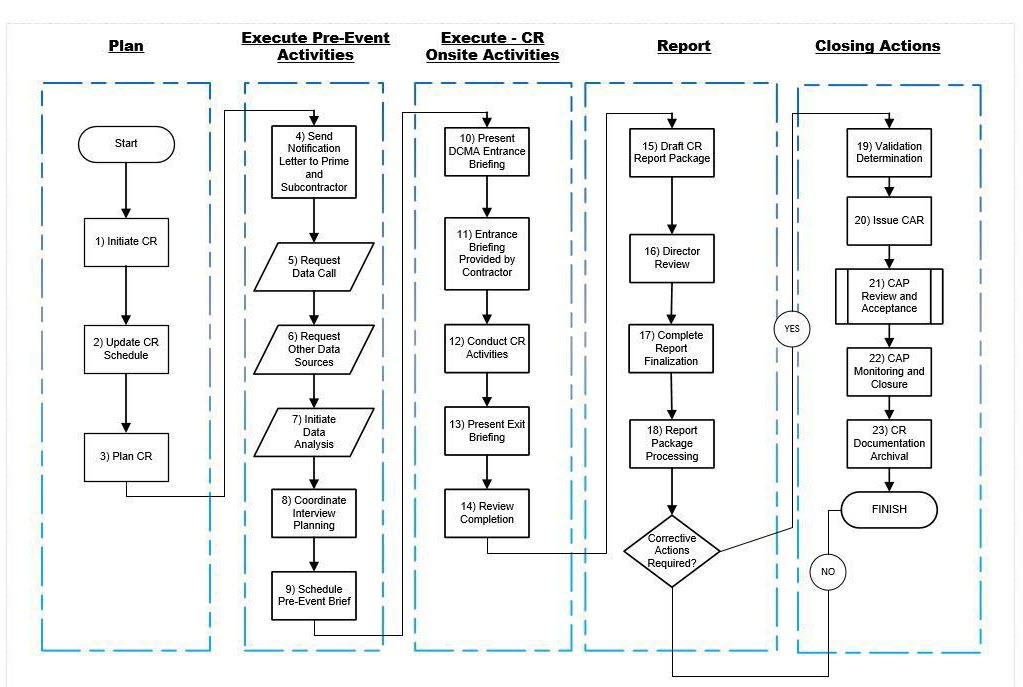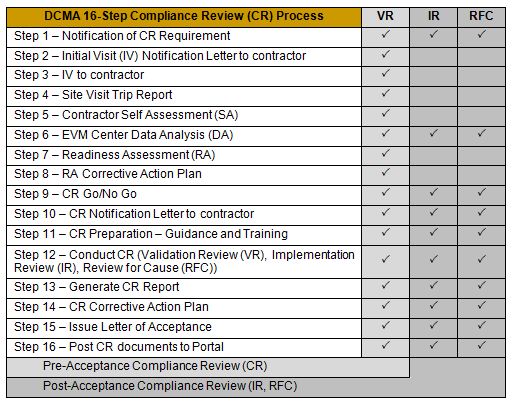Updates to the Compliance Review Series of Blogs

2020 Update
Humphreys & Associates has posted a 2020 update to the series of blogs discussing the DCMA Compliance Review (CR) process. “Compliance Review” is the term used for the formal EVM System review DCMA performs to determine a contractor’s compliance with the EIA-748 Standard for EVMS guidelines. This can also include, as applicable, Surveillance Reviews and Reviews for Cause (RFC).
DCMA used to follow a 16 Step compliance review process. This changed to an 8 Step process with the release of the DCMA Instruction 208 (DCMA-INST 208) titled “Earned Value Management System Compliance Reviews Instruction.” This Instruction has been rescinded and replaced with a set of DCMA Business Practices (BP). These Business Practices split out topics that the old DCMA Instruction 208 covered in one document. Whether you are a contractor new to the EVM contracting environment or a seasoned veteran, if the Earned Value Management System (EVMS) compliance and acceptance authority is the Defense Contract Management Agency (DCMA), these new Business Practices apply to you.
The four updated blogs include:
- EVMS Compliance Review Series #1 – Prep for the DCMA Compliance Review Process. This blog presents the set of DCMA Business Practices (BP) that define the EVMS and Review process and specifically discusses Business Practice 6 “Compliance Review Execution.” It also discusses what you can expect should you need to complete the DCMA Compliance Review process through the 5 phases and 23 Steps outlined in BP6. It is critical you are able to complete each step in the process successfully the first time through to prevent delays. The best way to make sure you are prepared is to conduct one or more internal EVMS Mock Reviews, the topic for the next blog.
- EVMS Compliance Review Series #2 – Conducting Internal Mock Reviews (Self Assessments). This blog discusses the importance of conducting a thorough internal review of your EVMS. You may or may not have the expertise in-house to conduct this simulation of a Compliance Review. An independent third party can help you prepare for a DCMA compliance review. The objective is to conduct the EVMS Mock Review to simulate everything DCMA will do. DCMA also expects a thorough scrub of the schedule and cost data – data traceability and integrity is essential.
- EVMS Compliance Review Series #3 – Using Storyboards to Depict the Entire EVMS. Do you need a refresher on the role of storyboards in a compliance review? Storyboards can make a difference in training your personnel and explaining to the DCMA personnel how your EVMS works. Storyboards can take many forms, and if you don’t have one in place, consider starting with the flow diagrams in your EVM System Description.
- EVMS Compliance Review Series #4 – Training to Prepare for Interviews. This blog highlights the importance of conducting training for your personnel, particularly the control account managers (CAMs), so they are able to complete successful interviews with DCMA personnel. H&A recommends completing a three step training process to proactively address any issues.
Help Preparing for a Compliance Review
Do you need help preparing for a DCMA compliance or surveillance review? Download the set of DCMA Business Practices and read our updated blogs so you have an idea of what is ahead. Humphreys & Associates can help you conduct a Mock EVMS Review, perform a data quality assessment, create a storyboard, or conduct EVMS interview training and mentoring for your personnel. Call us today at (714) 685-1730 or email us.
Updates to the Compliance Review Series of Blogs Read Post »


